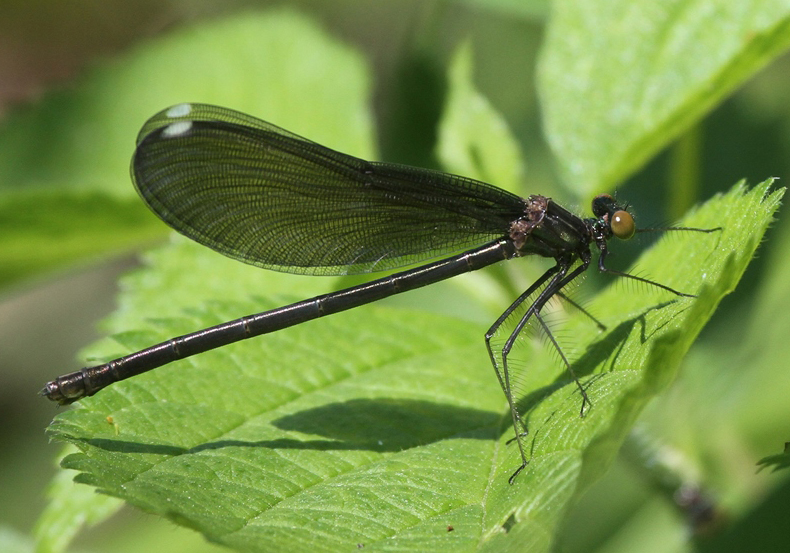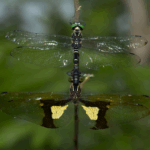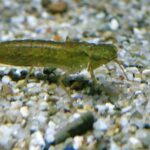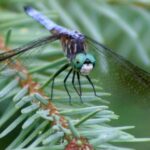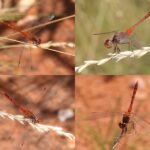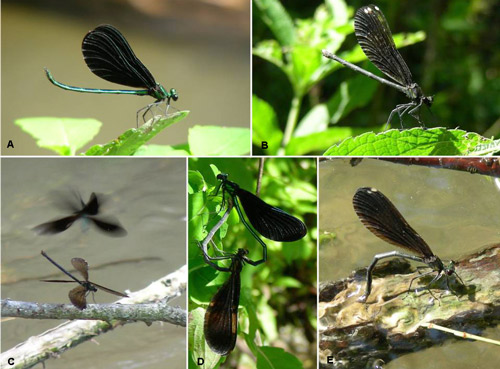
The ebony jewelwing (Calopteryx maculata) is a species of broad-winged damselfly. One of about 150 species of Calopterygidae, it is found in the eastern U.S. and southeastern Canada, ranging west to the Great Plains. Other common names include black-winged damselfly.
It is between 39–57 mm (1.5–2.2 in). The male has a metallic blue-green body and black wings. The female is duller brown with smoky wings that have white spots near the tips (pseudopterostigmata). The naiad is pale brown with darker markings. There are some spots in the wings.
Habitat
It lives near wooded streams and rivers, but it can move far from water.
Calopteryx maculata (Beauvois), the ebony jewelwing, is a large damselfly in the family Calopterygidae that is endemic to eastern North America. The ebony jewelwing has an iridescent green body with dark wings. Wings of the male ebony jewelwing are completely black, while wings of the female are smoky bronze with a distinct white spot (pterostigma) at the outer edge of the forewing. The combination of iridescent green body and dark wings distinguish this species from all other damselflies in the family Calopterygidae, and from other damselflies in North America. The ebony jewelwing is not listed as a species of concern.
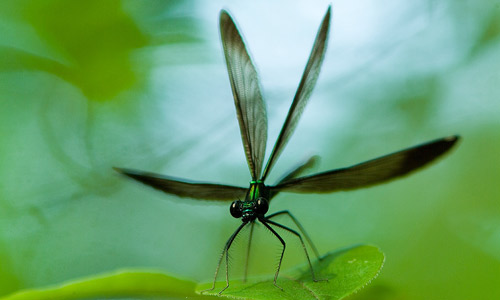
Depending on the light, the male’s gorgeous iridescent body can appear green or blue. His wings are a solid black. The female is no less lovely, with a greenish-bronze body and smoky-brown wings. Tiny white squares (stigmas) are quite apparent on the upper tips of her wings.
A jewelwing that flits out from and then returns to a perch along a small stream is busy feeding. You may not see the flying insects it is capturing and eating, for they can be as small as gnats. But a good feeding perch will be used for hours or days, and a territory of six to ten feet along the stream will be defended from other damselflies.
The flapping of forewings and hindwings simultaneously causes the laid-back fluttering flight of the ebony jewelwing. But when males are courting females, the flight pattern changes; the wings are flapped alternately, and more quickly. This, and a territory along a stretch of stream with plenty of aquatic vegetation, will attract a female to a male.
The female requires plant material just below the water’s surface in which to lay her 600 or so eggs. She dips just the tip of her abdomen underwater and inserts her ovipositor into a plant’s stem or leaf to deposit her eggs. The male remains in the vicinity to guard her, chasing off rival males.
Their nymphal offspring will grow and develop in the aquatic environment of the stream, feeding on insect larvae and other invertebrates below the water’s surface. Early next summer they will leave the water, their exoskeletons will split down the back and beautiful-winged damselflies will emerge to take flight like magical woodland fairies.
The ebony jewelwing (Calopteryx maculata) is a large damselfly of shaded streamsides. Your first impression when you spot its jet-black wings fluttering lazily through sun-dappled vegetation is that a dark butterfly has crossed your path. As it lands on a branch or leaf, the ebony jewelwing’s form takes shape and you can behold it for what it truly is – a magnificent damselfly. There is no doubt why the genus was given the name Calopteryx, which means “beautiful wing.”
This two-inch long damselfly is found in the eastern two-thirds of the United States, usually seen from June to August in our area. It belongs to the family known as broad-winged damselflies, which have broad, colored wings. They normally hold their wings closed over their backs while they perch horizontally, though a quick opening and closing of the wings is sometimes used to signal their location to other jewelwings.
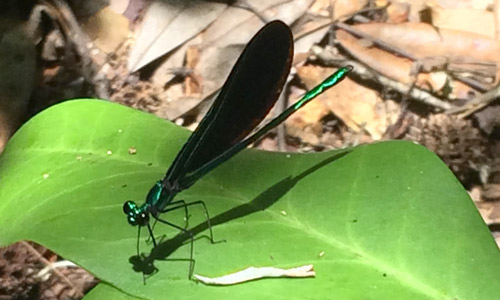
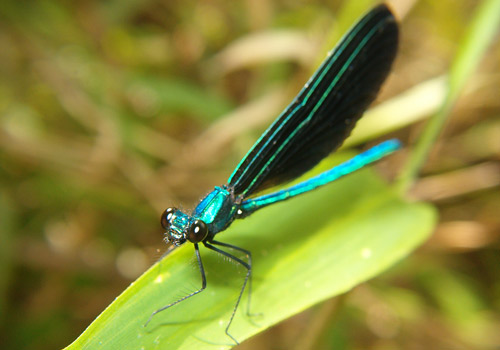
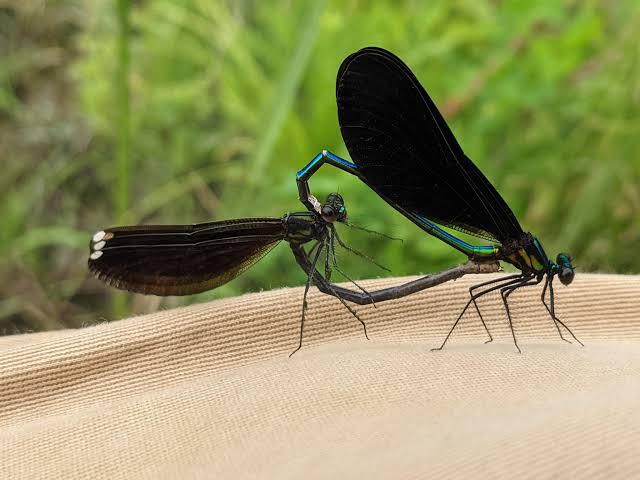
Food Habits
Larvae feed on a wide variety of aquatic insects, such as mosquito larvae, other aquatic fly larvae, mayfly larvae, and freshwater shrimp.
Adult- This damselfly will eat almost any soft-bodied flying insect including mosquitoes, flies, small moths, mayflies, and flying ants or termites.
General Description
This is a large damselfly about 1 ¾ to 2 ¼ inches long (45 to 52 mm). The body is robust, especially in the females. The abdoman color is an unmistakable iridescent green or blue. The entire wing is black with white stigmas. Flight can look erratic with the black wings, as they are weak but graceful flyers.
Diagnostic Characteristics
This is a large damselfly about 1 ¾ to 2 ¼ inches long (45 to 52 mm). The body is robust, especially in the females. The color is an unmistakable iridescent green or blue. The entire wing is black, whereas the River Jewelwing is only partially colored.
Range Comments
Known from one damaged larval specimen reported on the Tongue River. Could be found throughout the southeastern part of Montana in larger warm-water prairie rivers, although we haven’t seen any on the Powder River with extensive sampling efforts.
Life Cycle
The cylindrical eggs of the ebony jewelwing are laid in slow moving streams and rivers where the aquatic and predaceous immatures, known as naiads (juveniles), hatch and then hunt for small aquatic prey, including aquatic insects, worms, and small fish. Naiads are olive green to brown in color. Three caudal gills that project from the base of the abdomen regulate oxygen exchange as well as aid in directional swimming (Capinera 2016) (Figure 7). As with the adults, naiads of ebony jewelwings are diurnal and obligate carnivores. To capture prey, they rapidly extend their long, prehensile lower lip (labium) and seize their prey (Capinera 2016).
Damselfly naiads are important prey for many animals, such as fish, birds, and frogs, as well as a variety of aquatic invertebrates (Hussain and Ahmed 2003). Adults are preyed upon by dragonflies, birds, fish, spiders, and frogs (Waage 1972). Naiads undergo 11-12 molts in a single year (Martin 1939), then crawl out of the water onto nearby vegetation to molt a final time into a winged adult, with sexual maturity developing a few days later (Nevin 1929).
The recently eclosed adult expands its wings by forcing hemolymph (insect blood) into the wing veins using an organ (the pulsatile organ) near the base of the wings. Once the wings are fully extended, the teneral (still soft) body of the recently eclosed adult damselfly must sclerotize (harden) before flight is possible (Silsby 2001). Both adult males and adult females are relatively short-lived, with an average lifespan of just 15-17 days in the wild (Waage 1972). Adult ebony jewelwings hunt for resting arthropods but can also catch prey in midflight (Capinera 2010), such as gnats, mosquitoes, and crane flies, using densely spined legs to trap their prey.
Mating Behavior: Adult males are territorial and compete with one another for high-quality breeding sites around slow moving vegetated streams and rivers. Males attempt to attract females by performing a “cross” display (Figure 8). This display is performed by facing the female and turning the hindwings downward while keeping them perpendicular to the body, then raising the forewings and abdomen, revealing a pale area on the underside of the abdomen.
Having successfully attracted a female, the male begins his fluttering courtship, which involves whirling his wings and hovering in front of her, followed by walking down her wings to assume his position for copulation (Alcock 1979). When the female accepts the male, the male grasps her prothorax with the copulatory appendages at the end of his abdomen and she responds by raising the tip of her abdomen to the underside of his abdomen (Capinera 2016) (Figure 9 A-E). This heart-shaped arrangement during copulation is known as a mating wheel. The male is equipped with a specialized secondary penis on the underside of his abdomen, which accepts sperm from the primary penis on the tip of the abdomen and is then used to transfer his sperm to the female’s spermatheca (sperm storage organ). The penis also contains small, brush-like structures, which are used by the male to remove sperm in the spermatheca deposited by previous mates, thereby reducing competition with other males (Waage 1979). On average, ebony jewelwings copulate for three hours, although this time can range from one to six hours (Roughgarden 2004).
Watch for Behavior
These insects have the unnerving habit of turning their heads and watching their human observers. It is one of these insects fascinating qualities that has made it a favorite of many.
Also watch for courting behavior. A perched female, when courted by a male, will accept his presence by rapidly opening and closing her wings. If she rejects him, however, she will open her wings and leave them extended. Males will frequently flick their wings to warn off completing males.

